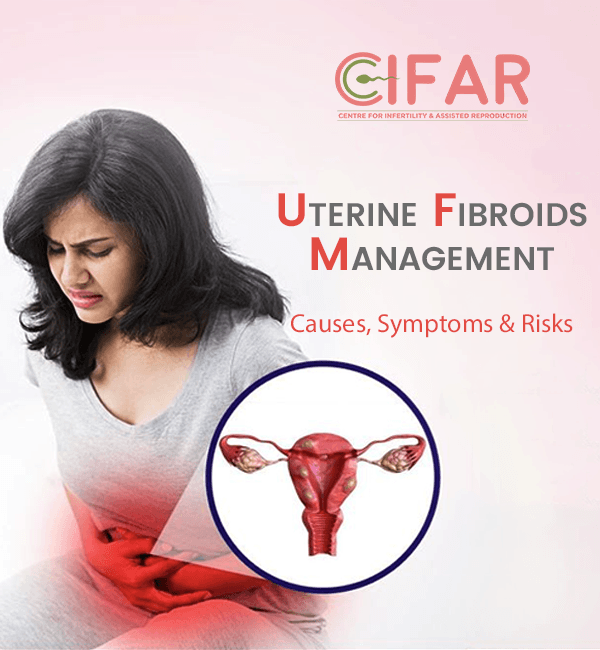Uterine Fibroids, also known as leiomyomas or myomas, are the most commonly found uterine tumours. Fibroids are noncancerous tumors that appear in the uterus during the childbearing age of a woman.
Fibroids vary widely in size -from microscopic to bulky growth that can distort and enlarge the uterus. The patient can have a single fibroid or multiple ones. Most women have a growth of fibroids once in their lifetime. Fibroids do not often show any symptoms and thus are hard to diagnose.
Symptoms, Causes, and Types of Fibroids
The symptoms of Fibroid become visible in some cases. They are:
- Heavy and prolonged menstrual bleeding
- Pelvic pressure or pain
- Frequent urination
- Constipation
- Backache or leg pains
No actual cause of fibroid growth has been found by experts, but the factors which are most likely to cause uterine fibroids are:
- Genetic changes. – Many fibroids contain genes that differ from those in typical uterine muscle cells.
- Hormones- Oestrogen and progesterone are the two hormones that cause the development of the uterine lining during each menstrual cycle in preparation for pregnancy. Fibroids contain more estrogen and progesterone receptors than typical uterine muscle cells do.
- Extracellular matrix (ECM)- ECM is the material that makes cells stick together, like mortar between bricks. ECM is higher in fibroids and is what makes them fibrous.
Fibroids are normally classified into three types:
- Intramural fibroids grow within the muscular uterine wall.
- Submucosal fibroids bulge into the uterine cavity.
- Subserosal fibroids project to the outside of the uterus.
Many fibroids that have been present during pregnancy shrink or disappear after pregnancy, as the uterus goes back to its usual size
Fibroids usually don’t have much effect on pregnancy. However, it’s possible in some cases that fibroids — especially submucosal fibroids — could cause infertility or pregnancy loss.
Fibroids may also raise the risk of certain pregnancy complications, such as placental abruption, fetal growth restriction, and preterm delivery.
Diagnosis and Treatment
Uterine fibroids are frequently found incidentally during a routine pelvic exam. The patient can be asked to undergo the following tests as well:
- Imaging Tests such as Ultrasound, MRI
- Hysterosonography which is also called a saline infusion sonogram uses sterile salt water (saline) to expand the uterine cavity, making it easier to get images of submucosal fibroids.
- Hysterosalpingography uses a dye to highlight the uterine cavity and fallopian tubes on X-ray images. This test can help your doctor determine if your fallopian tubes are open or blocked and can show some submucosal fibroids.
- Hysteroscopy includes inserting a small, lighted telescope called a hysteroscope through your cervix into your uterus. Your doctor then injects saline into your uterus, expanding the uterine cavity and allowing your doctor to examine the walls of your uterus and the openings of your fallopian tubes.
The treatment of Uterine Fibroids may include medications, non-invasive or minimally invasive surgery, or laparoscopic surgery. Currently, surgery is the only viable option for fibroid management.
Medications for uterine fibroids target hormones that regulate your menstrual cycle, treating symptoms such as heavy menstrual bleeding and pelvic pressure. They can’t eliminate fibroids but make them shrink.
- Gonadotropin-releasing hormone (GnRH) agonists are one of the common medications used to treat fibroids. They block the production of estrogen and progesterone, putting you into a temporary menopause-like state. As a result, menstruation stops, fibroids shrink and anemia often improves.
- Uterine artery embolization is a popular minimally invasive surgical procedure to treat fibroids. Small particles (embolic agents) are injected into the arteries supplying the uterus, cutting off blood flow to fibroids, causing them to shrink and die.
- Laparoscopic or robotic myomectomy is used when fibroids are small in number. The surgeon removes the fibroids, leaving the uterus in place.
- Hysteroscopic myomectomy is a surgical procedure used if the fibroids are contained inside the uterus (submucosal). Your surgeon accesses and removes fibroids using instruments inserted through your vagina and cervix into your uterus.
- Hysterectomy is a surgical procedure to remove the uterus. It remains the only proven permanent solution for uterine fibroids. Hysterectomy ends your ability to bear children.
There is growing evidence of the crucial role of progesterone pathways in the pathophysiology of uterine fibroids due to the use of selective progesterone receptor modulators (SPRMs) such as ulipristal acetate (UPA). The efficacy of long-term intermittent use of UPA was recently demonstrated by randomized controlled studies.
The need for alternatives to surgical intervention is very real for Fibroid Management, especially for women seeking to preserve their fertility.
The best treatment for Uterine Fibroids is available at CIFAR Hospital, Gurugram. The hospital boasts of a team of the Best fertility experts in Gurugram and a holistic environment. If you are suffering from the symptoms of Uterine Fibroids or any infertility condition, please immediately visit CIFAR Hospital Gurugram.

